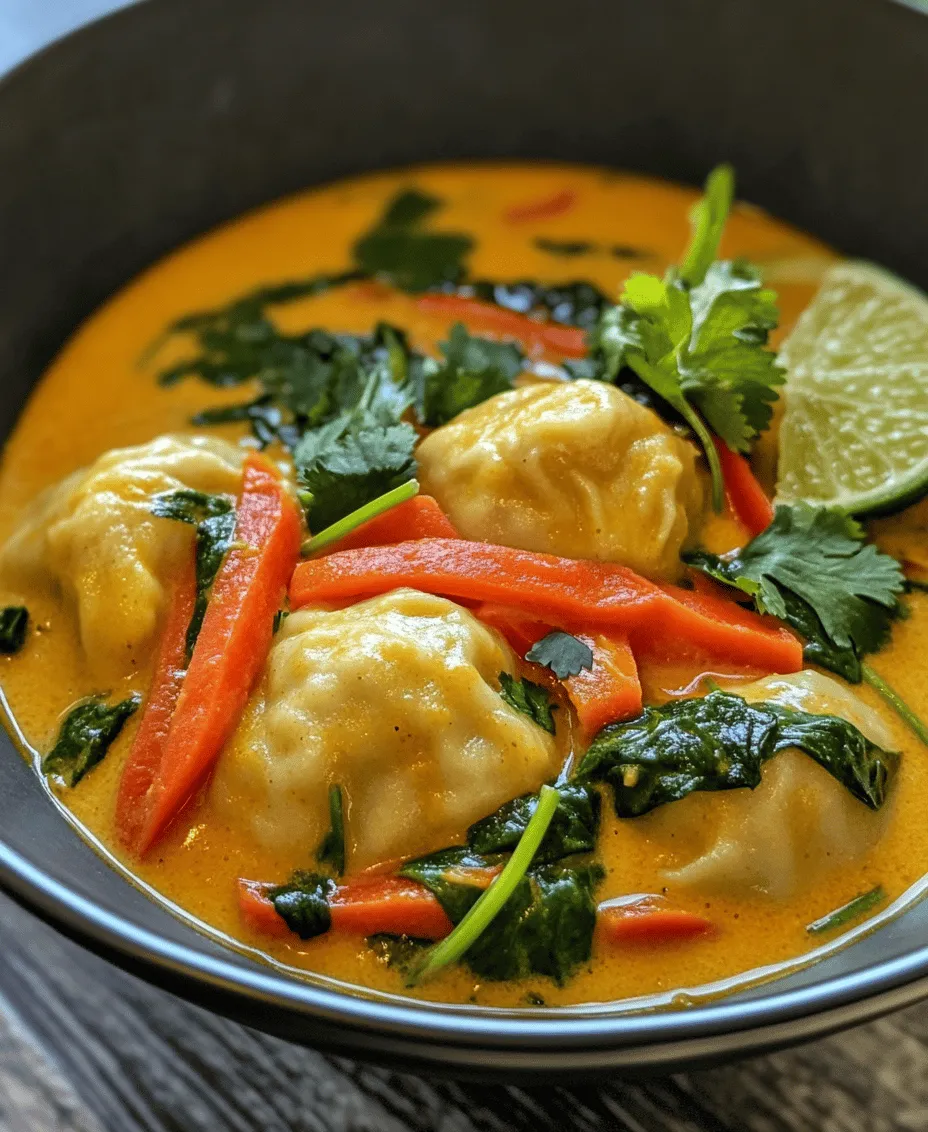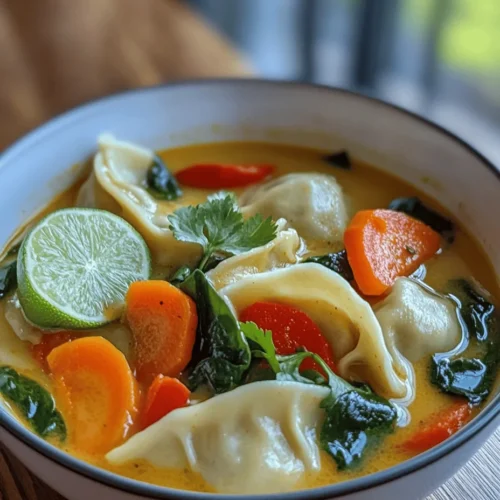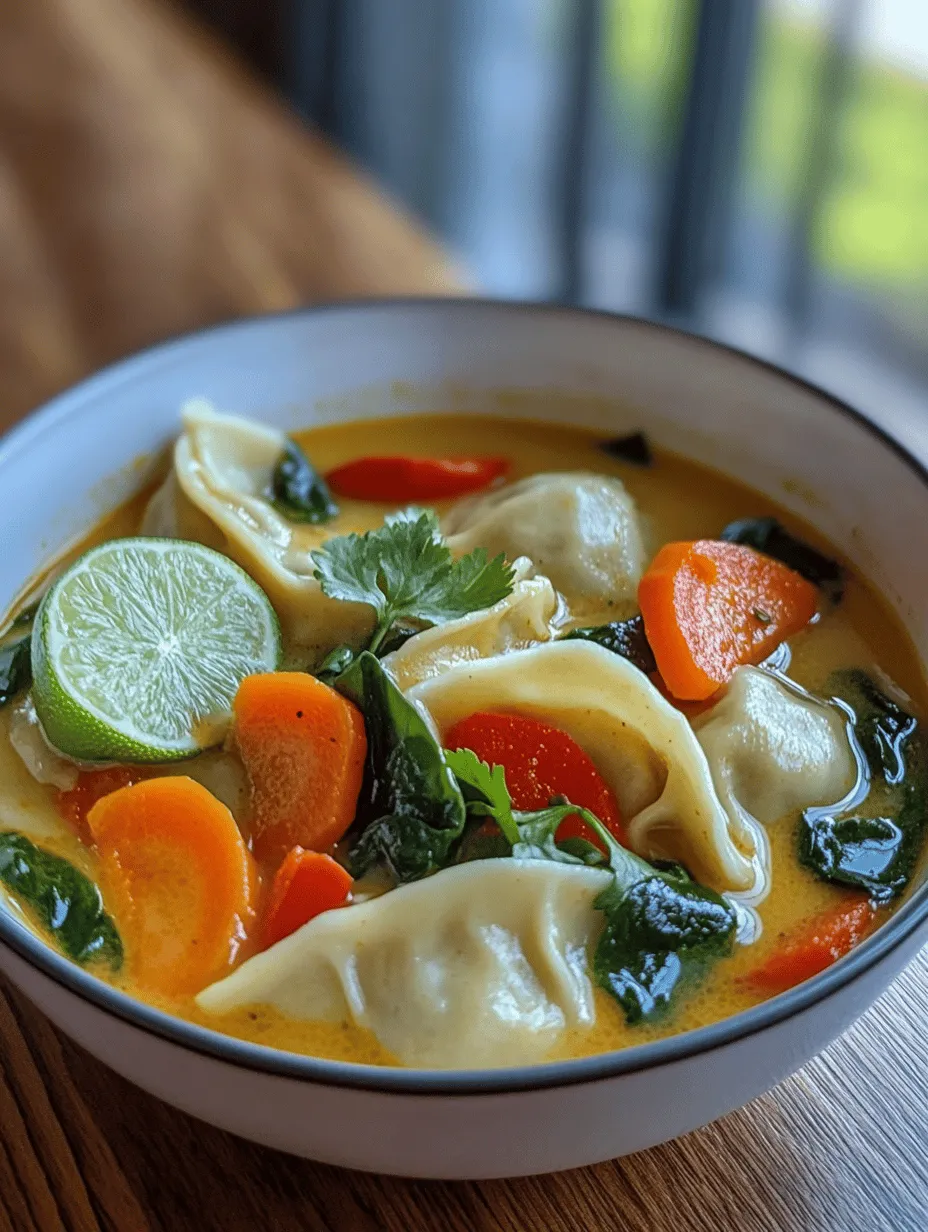Introduction
As the weather turns chilly and the days grow shorter, there’s nothing quite like a steaming bowl of soup to bring warmth and comfort to our lives. Enter the Spicy & Savory Curry Dumpling Soup—a dish that beautifully marries the bold flavors of curry with the delightful texture of dumplings. This recipe is not just a meal; it’s an experience that invites you to savor every spoonful.
Curry soup is beloved around the world for its aromatic spices and rich, satisfying flavors. When paired with tender, homemade dumplings, it transforms into a dish that’s both comforting and nourishing. Each bite offers a delightful fusion of spices, textures, and health benefits, making it a perfect choice for anyone seeking a hearty meal that’s also packed with nutrition.
The ingredients in this dish are chosen not only for their incredible flavors but also for their health benefits. From the anti-inflammatory properties of turmeric to the immune-boosting benefits of garlic and ginger, this soup is as good for your body as it is for your taste buds.
Understanding Curry and Its Varieties
Curry is more than just a dish; it’s a cooking style that encompasses a wide range of flavors and ingredients, reflecting the diverse cultures from which it originates. At its core, curry is characterized by its use of spices, which can include anything from coriander and cumin to cardamom and chili peppers. Each region has its own unique interpretation of curry, influenced by local ingredients and traditions.
In Western cuisine, curry often refers to a blend of spices known as curry powder. This powder can vary widely in flavor, heat, and aroma, depending on its composition. For instance, Indian curry powders may include turmeric, coriander, and garam masala, while Thai curry pastes typically feature fresh herbs, chili, and lime leaves. Understanding these differences can elevate your cooking, allowing you to select the right curry powder for your dish.
The role of spices in curry goes beyond mere flavor; many spices are celebrated for their health benefits. For example, turmeric contains curcumin, a compound known for its anti-inflammatory and antioxidant properties. Similarly, cumin and coriander support digestion and overall wellness. By incorporating these spices into your cooking, not only do you enhance the flavor profile of your dishes, but you also promote better health.
The Heart of the Dish: Dumplings
Dumplings hold a special place in the culinary traditions of many cultures around the globe. From the delicate Chinese jiaozi to the hearty Polish pierogi, these versatile morsels can be filled with a myriad of ingredients and cooked in various ways. They often serve as a symbol of comfort and community, frequently enjoyed during family gatherings and celebrations.
Making dumplings from scratch may seem daunting, but it’s a rewarding process that allows you to customize the fillings and flavors to your liking. The key to perfect dumplings lies in the dough and the filling. A well-made dough should be pliable yet firm, able to hold its shape during cooking while providing a tender bite. The filling can be anything from minced meat and vegetables to plant-based options, giving you the freedom to experiment with flavors and textures.
Using fresh ingredients is crucial for creating delicious dumplings. Fresh vegetables, high-quality proteins, and aromatic herbs all contribute to a more vibrant filling. Additionally, the texture of the dumplings is essential; they should be soft yet have a slight bite, creating a delightful contrast against the smooth, flavorful soup.
Creating the Soup Base: A Flavorful Foundation
The foundation of any great curry dish lies in its soup base, which must be robust and full of character. A well-prepared soup base not only enhances the overall flavor but also complements the dumplings beautifully, ensuring that every spoonful is a harmonious blend of spices and ingredients.
To create a flavorful soup base, we will start with a combination of aromatic ingredients that lay the groundwork for the dish. Coconut oil is an excellent choice for sautéing, as it adds a subtle sweetness and richness to the soup while also offering health benefits. Rich in medium-chain triglycerides (MCTs), coconut oil is known to support metabolism and provide a quick source of energy.
Onion, garlic, and ginger are the trifecta of aromatics that will elevate the flavor of your soup to new heights. Sautéed together, they create a fragrant base that infuses the entire dish with warmth and depth. Onion adds sweetness and body, garlic brings a sharp punch, and ginger contributes a refreshing zing, making this trio indispensable in many cuisines, particularly in Asian cooking.
Next, we delve into the heart of the flavor profile: the curry powder and turmeric. Curry powder, with its complex blend of spices, serves as the star ingredient, while turmeric not only enhances the color of the soup but also adds its unique earthy flavor. Both spices are known for their health benefits, with turmeric being particularly recognized for its anti-inflammatory properties.
In our Spicy & Savory Curry Dumpling Soup, the soup base is crafted to be bold yet balanced, allowing the flavors of the dumplings to shine through. This is where we will begin to layer our ingredients, ensuring that each one contributes to the vibrant tapestry of flavors.
Crafting the Perfect Spicy & Savory Curry Dumpling Soup: Step-by-Step Guide
Now that we have a solid understanding of the flavors and ingredients that will make our Spicy & Savory Curry Dumpling Soup truly exceptional, let’s dive into the step-by-step process of creating this delicious dish.
Step 1: Gather Your Ingredients
Before we start cooking, it’s essential to gather all the necessary ingredients. This not only makes the cooking process smoother but also ensures you have everything ready at hand.
For the Dumplings:
– All-purpose flour (or a gluten-free alternative)
– Water
– Salt
– Filling of your choice (ground meat, vegetables, or a combination)
– Fresh herbs (optional)
For the Soup Base:
– Coconut oil
– Onion, finely chopped
– Garlic, minced
– Fresh ginger, grated
– Curry powder (adjust based on your spice preference)
– Turmeric powder
– Vegetable or chicken broth
– Coconut milk
– Fresh vegetables (such as bell peppers, carrots, or greens)
Step 2: Prepare the Dumplings
1. Make the Dough: In a mixing bowl, combine the all-purpose flour and salt, gradually adding water until a smooth dough forms. Knead the dough for about 5-10 minutes until it becomes elastic. Cover with a damp cloth and let it rest while you prepare the filling.
2. Prepare the Filling: Choose your filling—whether it’s seasoned ground meat, finely chopped vegetables, or a mix. If using meat, ensure it’s cooked and seasoned well with salt, pepper, and any herbs you desire.
3. Form the Dumplings: On a lightly floured surface, roll out the dough into thin sheets. Cut out circles using a round cutter. Place a small amount of filling in the center of each circle, then fold the dough over to create a half-moon shape. Pinch the edges to seal tightly, ensuring no filling escapes during cooking.
Step 3: Create the Soup Base
1. Sauté Aromatics: In a large pot, heat the coconut oil over medium heat. Add the chopped onion and sauté until translucent. Then, stir in the minced garlic and grated ginger, cooking until fragrant.
2. Add Spices: Sprinkle in the curry powder and turmeric, stirring continuously for about a minute to toast the spices and release their natural oils.
3. Add Liquids: Pour in your broth and coconut milk, stirring to combine. Bring the mixture to a gentle simmer, allowing the flavors to meld.
4. Incorporate Vegetables: Add your chosen vegetables to the soup base, letting them cook until tender—this will usually take about 5-7 minutes.
With the dumplings prepared and the soup base simmering, we are on the brink of creating a meal that is not only delicious but also richly layered in flavor. Each step brings us closer to that comforting bowl of Spicy & Savory Curry Dumpling Soup, ready to be savored and shared.
Stay tuned for the next part, where we will explore the final steps in crafting this delightful dish, including cooking the dumplings and serving suggestions.

Techniques for Kneading and Shaping the Dough
Kneading the dough is a crucial step in achieving the right texture for your dumplings. Start by combining the flour and salt in a large mixing bowl. Gradually add water, mixing until a rough dough forms. Once combined, transfer the dough onto a floured surface and begin kneading. Use the palms of your hands to push the dough away from you, then fold it back over itself. This process should be repeated for about 5-10 minutes until the dough is smooth and elastic.
To shape the dumplings, divide the dough into equal-sized pieces, typically about the size of a golf ball. Roll each piece into a thin circle, about 3 inches in diameter. The edges should be thinner than the center to ensure even cooking and a delightful texture. If you find the dough sticking to your surface or rolling pin, sprinkle a little extra flour as needed.
Tips for Achieving the Perfect Texture
The perfect dumpling texture should be soft yet firm enough to hold its shape. Here are some tips to help you achieve that ideal consistency:
1. Hydration: Ensure that the dough is not too dry. A well-hydrated dough will yield softer dumplings. Conversely, over-hydrated dough can lead to sticky and difficult-to-handle dumplings.
2. Resting Period: Allow the kneaded dough to rest for at least 30 minutes. This resting period helps the gluten relax, making the dough easier to roll out and shape.
3. Thickness: Keep the dumpling wrappers thin but not so thin that they break easily. A thickness of about 1/8 inch is ideal.
4. Sealing: When filling the dumplings, ensure that you seal them properly to prevent any filling from leaking during cooking. Pinch the edges tightly, and consider crimping for added security.
Step-by-Step Preparation of the Soup
Once you have your dumplings ready, it’s time to prepare the savory curry soup. Here’s how to do it:
1. Ingredients: Gather your ingredients for the soup, including vegetable broth, coconut milk, curry paste, and your selected vegetables (carrots, bell peppers, and spinach).
2. Sauté Aromatics: In a large pot, heat a tablespoon of oil over medium heat. Add chopped onions, garlic, and ginger. Sauté them until the onions are translucent and fragrant, about 3-5 minutes. This initial step builds the flavor base for your soup.
3. Add Curry Paste: Stir in the curry paste and cook for an additional minute. This allows the spices to bloom, enhancing their flavors.
4. Pour in Liquids: Add the vegetable broth and coconut milk to the pot. Bring the mixture to a gentle simmer, allowing the flavors to meld for about 10 minutes.
5. Incorporate Vegetables: Add your chopped carrots and bell peppers to the simmering broth. Cook for about 5-7 minutes until they begin to soften.
6. Add Dumplings: Gently drop your prepared dumplings into the soup. Be careful not to overcrowd the pot, as this can lower the temperature of the soup. Allow the dumplings to cook for about 8-10 minutes until they float to the surface, indicating they are cooked through.
Sautéing Techniques for Optimal Flavor Extraction
Sautéing is an essential technique in building flavor in your curry soup. Here are some best practices:
– Use High Heat: Ensure your pan is hot before adding ingredients. This helps to sear the onions and garlic, creating a deeper flavor profile.
– Don’t Overcrowd the Pan: If you add too many ingredients at once, they will steam rather than sauté. Cook in batches if necessary.
– Deglaze for Depth: If you notice browned bits stuck to the bottom of the pot after sautéing, add a splash of broth to deglaze. This incorporates those flavorful bits back into your soup.
How to Balance the Spices and Seasonings
Balancing the spices in your soup is crucial for a harmonious flavor. Here are some tips:
– Taste as You Go: Regularly taste the soup as you cook. This allows you to adjust the flavor profile by adding more salt, spice, or acid as needed.
– Add Acidity: A splash of lime juice or a dash of vinegar can brighten up the flavors. If the soup is too rich, acidity will help cut through the heaviness.
– Layer Flavors: Start with a base of aromatics and build up your flavor by adding spices gradually. This method allows you to control the intensity of the flavor.
Incorporating Vegetables for Nutrition and Flavor
Vegetables play a significant role in your curry dumpling soup, both in terms of nutrition and enhancing the overall flavor.
Importance of Vegetables in the Soup
Vegetables not only add color and texture but also contribute essential nutrients. They provide vitamins, minerals, and dietary fiber, making your soup more wholesome.
Benefits of Carrots, Bell Peppers, and Spinach
– Carrots: These root vegetables infuse sweetness and a vibrant color into your soup. They are rich in beta-carotene, which is converted into vitamin A in the body, supporting eye health.
– Bell Peppers: Available in various colors, bell peppers add a crunchy texture and a slight sweetness. They are an excellent source of vitamin C, which boosts the immune system.
– Spinach: This leafy green adds a dose of iron and other essential nutrients. Spinach wilts beautifully into the soup, providing a lovely contrast to the dumplings.
Suggestions for Vegetable Substitutions Based on Seasonal Availability
Feel free to customize your soup based on seasonal vegetables. Here are some suggestions:
– Zucchini: A great summer substitute that adds a refreshing crunch.
– Broccoli: Packed with nutrients and adds a delightful texture.
– Mushrooms: For a meaty texture and umami flavor, consider adding mushrooms.
Cooking the Dumplings: Timing and Techniques
Cooking dumplings in soup requires careful timing to ensure they are perfectly cooked without becoming soggy.
The Science of Cooking Dumplings in Soup
Dumplings are typically cooked by steaming or boiling. In soup, they benefit from the moist heat, which helps them expand and absorb flavors.
1. Timing: Generally, dumplings need about 8-10 minutes of cooking time in simmering soup. They will float to the surface when done, indicating they are cooked through.
2. Preventing Sogginess: To prevent dumplings from becoming soggy, avoid overcrowding the pot. Also, ensure the soup is at a gentle simmer rather than a rolling boil, which can cause dumplings to break apart.
Garnishing and Serving: Elevating Your Dish
Presentation is paramount in enhancing the overall dining experience. Here are some tips for garnishing and serving:
Importance of Presentation in Enhancing the Dining Experience
A well-presented dish not only looks appealing but also heightens the anticipation of enjoying it. Use colorful ingredients and thoughtful plating to make your soup visually enticing.
Suggestions for Garnishing with Fresh Cilantro and Lime
– Cilantro: Fresh cilantro adds a burst of color and a refreshing flavor. Sprinkle chopped cilantro over the soup just before serving for an aromatic finish.
– Lime Wedges: Serve lime wedges on the side for guests to squeeze into their soup. The acidity brightens the dish and complements the curry flavors beautifully.
Pairing Suggestions for Serving (e.g., Rice, Bread)
Consider pairing your Spicy & Savory Curry Dumpling Soup with:
– Steamed Rice: A bowl of steamed jasmine or basmati rice can be a perfect accompaniment, absorbing the delicious broth.
– Crusty Bread: Serve with a slice of warm, crusty bread for dipping, enhancing the whole experience.
Conclusion
In summary, the Spicy & Savory Curry Dumpling Soup is a delightful culinary journey filled with rich flavors and comforting textures. From the kneading of the dough to the careful boiling of the dumplings, every step contributes to a deliciously rewarding dish. The versatility of this soup allows for endless variations, accommodating a range of dietary preferences while ensuring a wholesome meal.
As you venture into creating this flavorful soup, remember the importance of balancing spices, incorporating seasonal vegetables, and presenting your dish in an inviting manner. Explore more recipes and culinary adventures in the world of soups and dumplings, and allow your kitchen to be a place of creativity and comfort.


